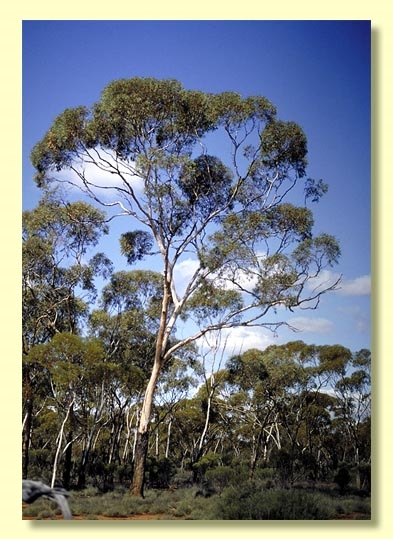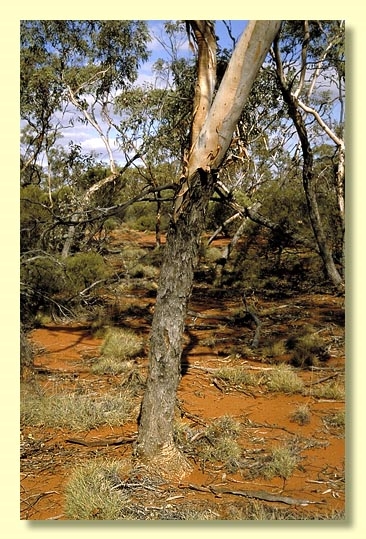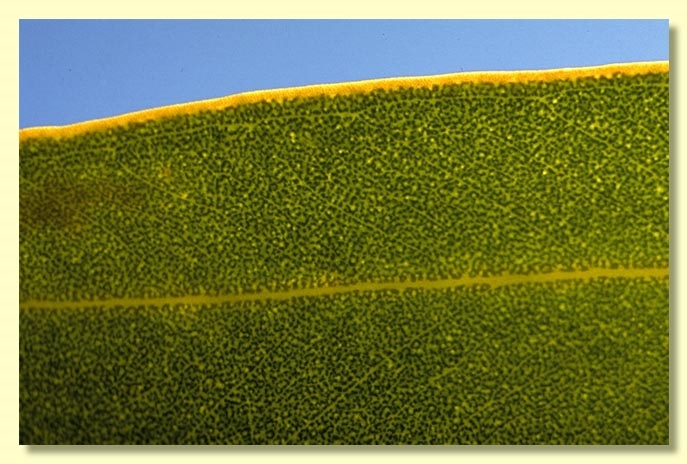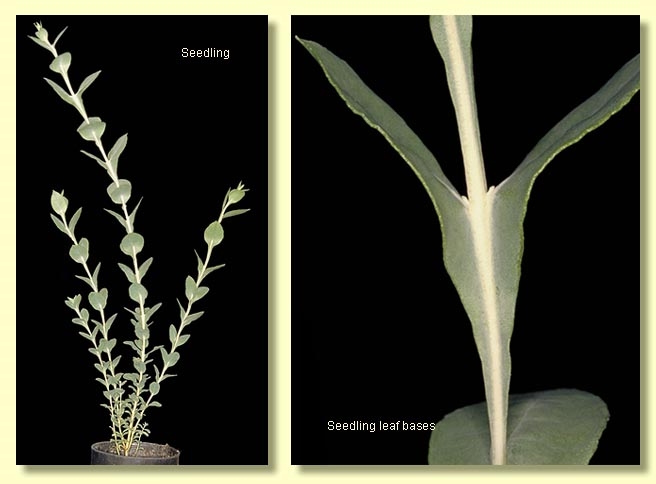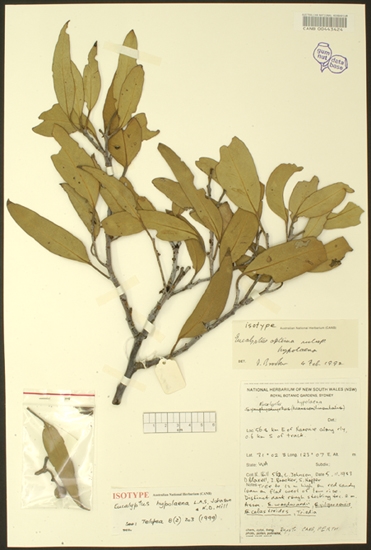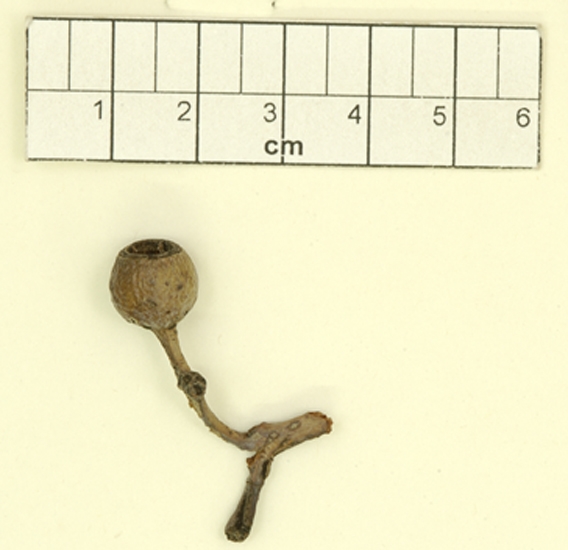Eucalyptus | Symphyomyrtus | Bisectae | Destitutae | Subulatae | Decurrentes
Euclid - Online edition
Eucalyptus hypolaena
T: Western Australia: 56.8 km E of Karonie along transcontinental railway, 2.6 km S of track, (31° 02'S 123° 07'E), 5 Nov. 1983, K.D.Hill 562, L.A.S.Johnson, D.F.Blaxell, M.I.H.Brooker & S.Hopper; holo: NSW; iso: CANB, K, PERTH. (see image of type specimen held at CANB)
Bark rough on the lower 2–3 m of trunk, dark grey to almost black, hard scaly-fibrous, flaky; smooth bark, white to grey to pale pink to pale orange; sometimes slightly powdery.
Branchlets glaucous; lacking oil glands in the pith.
Juvenile growth (coppice or field seedlings to 50 cm): stems glaucous, square in cross-section and prominently winged where leaf bases are decurrent; juvenile leaves opposite to alternate, sessile to shortly petiolate, broadly lanceolate to ovate to elliptical, 4–10 cm long, 2–4 cm wide, dull and glaucous, leaf bases decurrent, rounded to tapering further up the stem.
Adult leaves alternate, petiole (1.5)2–3(3.5) cm long; blade lanceolate to broadly lanceolate, 8–16 cm long, 1.3–3 cm wide, base tapering to petiole, concolorous, dull, blue-green to grey-green, side-veins usually at an acute angle to midrib, sometimes wider, densely reticulate, intramarginal vein parallel to and just within margin, oil glands numerous and mostly intersectional.
Inflorescence axillary unbranched, peduncles 0.5–1.3(1.6) cm long, usually pendulous; buds 7, pedicellate, pedicels 0.5–1 cm long. Mature buds ± ovoid to oblong (1.3–2.5 cm long, 0.6–0.8 cm wide), glaucous, scar present, operculum beaked to horn-shaped (0.7–1.8 cm long), stamens inflexed, anthers versatile, basifixed, globoid to cuboid, dehiscing by slits, style long, stigma tapered, locules 4, the placentae each with 4 vertical ovule rows. Flowers pale yellow.
Fruit erect to down-turned, pedicellate (pedicels 0.5–1 cm long), barrel-shaped to truncate-globose, rarely urceolate, glaucous but glaucescence weathering with age, 0.7–1 cm long, 0.8–1.2 cm wide, disc descending, valves 4, valve tips strongly exserted due to fragile style remnants.
Seeds glossy brown to grey, 1.5–2.2 mm long, ovoid or flattened-ovoid, rarely pointed at one end, occasionally with shallow longitudinal furrows on otherwise smooth dorsal surface, hilum ventral.
Cultivated seedlings (measured at node 10): cotyledons Y-shaped (bisected); stems square in cross-section and prominently winged due to decurrent leaf bases, slightly glaucous; leaves opposite, sessile, ovate to elliptical, dull grey-green to slightly glaucous, 2.5–8 cm long, 1.8–4 cm wide, leaf base decurrent on stem.
Flowering has been recorded in May, June, July August and September.
A small to medium-sized tree or mallee endemic to Western Australia, from the Great Victoria Desert east from Karonie and northwards. Characterised by its small tree or mallee habit with lignotuber present, the rough bark on the lower stems, its glaucous branchlets and the relatively large smooth globose to slightly urceolate fruit.
Eucalyptus hypolaena belongs in Eucalyptus subgenus Symphyomyrtus section Bisectae subsection Destitutae because buds have two opercula, cotyledons are Y-shaped and branchlets lack oil glands in the pith. Within this subsection E. hypolaena is part of a large taxonomic series Subulatae further characterised by globoid basifixed anthers, grey smooth seeds with shallow longitudinal furrows, and fruit with persistent exserted style remnants. Series Subulatae is divided principally into four subseries based on the juvenile leaves, one with spiral, crowded seedling phyllotaxis (subseries Spirales), another with decussate and strongly decurrent seedling leaves (subseries Decurrentes), another with decussate non-decurrent seedling leaves (subseries Decussatae), and a fourth with disjunct, petiolate seedling leaves (subseries Oleaginae).
Eucalyptus hypolaena is part of subseries Decurrentes. Within this group it is very closely related to E. optima. E. optima differs by having completely smooth-barked stems and is always a tree (mallet), never a mallee. It is also closely related to E. transcontintentalis and E. moderata which both occur west of E. hypolaena. Both differ by having smaller buds and fruit, with the fruit of E. hypolaena being truncate-globose to rarely slightly urceolate, contrasting with the smaller urceolate fruit of E. transcontinentalis and E. moderata.
Eucalyptus hypolaena: Greek hypo-, under and laina (Latinised as laena) cloak, alluding to the unshed basal bark.

